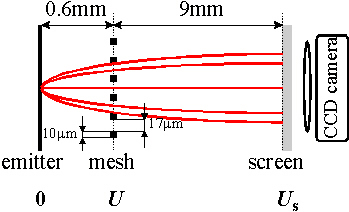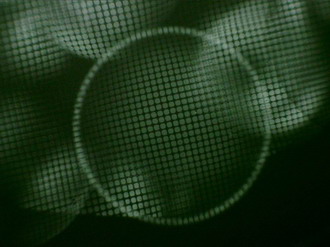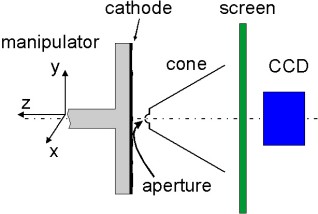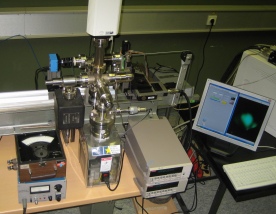Our research on field emission
Our research of potential use of field emission in applications can be divided into two themes:
- Study of nanoemitters as point-like electron sources
- Such electron source is of interest for application in electron microscope, electron plotter for nanolitography, analytical instruments, etc. In the last few years we have successfully upgraded the classical FEM with an additional electrode (fine planar grid) located between the emitter and anode. This enables us to determine the distance between the emitter and anode without being in physical contact in addition to current measurement and determination of angular distribution of emitted electrons. Fine planar grid partially intercepts electrons and thus superimposes grid-like shadow on the emission pattern. The latter reveals the configuration of individual emission site on the atomic scale. Such triode principle enhances the sensitivity as it is possible to achieve the effect of cold emission with quite low voltage on the grid and high accelerating voltage on the screen. Further benefit of triode principle is the determination of directions and angles of electrons emitted from sharp tips not being perpendicular to anode. When applying commonly used diode principle, the overlap of electron patterns from different tips cannot be decoupled.
- Study of Flat Broad Area Field Emission Cathodes (FBAFECs)
- is related to their great potential application in microwave tubes, x-ray tubes, flat electronic displays etc. Among the most promising materials are carbon based nanostructured coatings in the form of nanotubes or nanodiamond film, both deposited on metal substrates in RF plasma. Beside some improvements of two conventional evaluation methods used in the last years we developed our third method which required building an innovative instrument. These three methods used in the Vacuum laboratory are briefly described below:
pulsed mode investigation of FBAFECs enables to achieve much higher current densities than could be achieved in DC mode. The pulsed mode is in principle also closer to their planned potential application where the highest average current density is searched. Our present setup enables to perform high voltage pulses from 1 µs.
triode mode investigation of FBAFECs enables to measure the average current and to observe highly magnified emission pattern of individual emitting sites. For the concept shown in the figure below we apply 20 mm diameter metal mesh with 17 m squares. A typical voltage is 500 – 2000 V

Shema meritve in opazovanja ploščatih hladnih katod premera 20 mm. Pri velikem številu emitorjev se vzorci prekrivajo.
Emisijski vzorci na zaslonu pri jakosti polja pribl. 1 kV/mm. Zanimiv in le delno pojasnjen je nastanek pravilnih krogov, ki izhajajo z vrha enostenskih ogljikovih nanocevk .characterization of individual emission site of FBAFECs required a special device to be built, we named a scanning projection field emission microscope SPFEM. It operates in an UHV system where a flat cathode is located in front of a punctured electrode which extracts electrons by an electric field and directs them to a luminescent screen. The major improvement compared to previous concepts is made on the anode probe, realized as a hollow cone with a small hemispherical cap with a smooth-edged pinhole of 40 mm diameter. The luminescent screen composed of fine-grained phosphor particles (P-43 type) is deposited by sedimentation on an ITO coated glass substrate. The distance between the pinhole and the luminescent screen (dph-screen) is 30 mm. The FE pattern is observed directly by an optical microscope or recorded by a CCD camera. The instrument is designed for investigation of 25.5 mm diameter flat samples, mounted on a XYZ manipulator driven by stepper motors with 1 µm resolution. The pressure during the measurement is in the order of 5×10-10 mbar.

SPFEM, operation principle
SPFEM experimental setup
